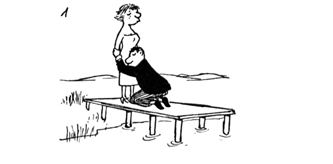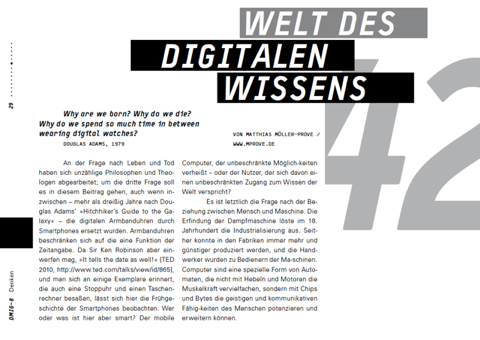Category: Interface Culture
Hans Rosling at TED
Yesterday’s BBC video was just the first course. Today I’ve collected a chronology of Hans Rosling’s talks at TED:
1) No more boring data / Debunking third-world myths with the best stats you’ve ever seen, February 2006
2) New insights on poverty and life around the world, March 2007
3) HIV: New facts and stunning data visuals, February 2009
4) Let my dataset change your mindset, June 2009
5) Asia’s rise – how and when, November 2009
6) On global population growth, June 2010
7) The good news of the decade?, September 2010
8) The magic washing machine, December 2010
And one final_
Hans Rosling’s answers to the TED and Reddit community interview
There are several more videos from Hans Rosling. Just check them out.
200 Countries x 200 Years
I find this video interesting for a couple of reasons:
- all the data is stored in databases. Better visualization methods are needed to grasp and understand the information.
- animated data visualizations can convey more insights than stills can.
- Hans Rosling is not Tom Cruise. But wall size displays and gestures will be part of the UI landscape tomorrow.
Related: Engaging Analytics with iPad by Julia Blyumen
Design for Conversations & Conversations for Design
The videos from coThinkTank are up. Here is the keynote given by Paul Pangaro:
coThinkTank 2011 Keynote: Design for Conversations & Conversations for Design by Dr. Paul Pangaro from newthinking on Vimeo.
Farewell Loriot
Loriot passed away today. Hence a repost from 2005:
A long time ago a German cartoonist named Loriot invented the Knollennasenmännchen (the potato nose man) that helped him to spend his life without the support of social welfare.
 One of his stories inspired me to coin the term The White Water Lily Effect (der Seeroseneffekt). Let me explain what this means. Projects tend to go off limit. Everything takes at least twice as long as estimated. And the estimations themselves turn out to be too optimistic, which does not change the truth in the sentence before. Fred Brooks discussed this problem for the area of software engineering in his wonderful book The Mythical Man-Month. In my opinion, user experience is no exception.
One of his stories inspired me to coin the term The White Water Lily Effect (der Seeroseneffekt). Let me explain what this means. Projects tend to go off limit. Everything takes at least twice as long as estimated. And the estimations themselves turn out to be too optimistic, which does not change the truth in the sentence before. Fred Brooks discussed this problem for the area of software engineering in his wonderful book The Mythical Man-Month. In my opinion, user experience is no exception.
Most, if not all UI problems get larger during the time you are working on them. To a certain extent this is natural because you get more deeply involved and gain a better understanding of the issue. You discuss the topic with colleagues and incorporate their point of view into the design. You discover new aspects that somehow match your topic. No big deal to cover them as well. Oh, there is not just your product; so what about consistency issues? Get some information on this. A certain technology might be crucial for your corporate strategy. Still, you have to think about cross-platform issues. I18N, L10N, G11N, A11Y, not to forget W10N and H16T. Are you still with me? W10N is “Way cool design”, “High quality product” the latter.
If that is not enough for you, consider that your problem is not the only one in the world. You have a flock of issues on your plate and you contribute to a bunch of other areas, too. The challenge is to keep the chunks of UI problems you address manageable. At the same time you have to keep an eye on the overall structure of the product.
I assume you have an idea of what I mean when talking about the white water lily effect. It poses an omnipresent danger. Being aware of this phenomenon is the first step to come out on top at the end.
PS_ “Ein Leben ohne Möpse ist möglich, aber sinnlos.” – Loriot
Sutherland’s Closing Remarks at HyperKult
Closing remarks by Ivan Sutherland at HyperKult XX. So exciting you could hear a pin drop_
Ivan Sutherland at HyperKult XX from mprove on Vimeo.
These are all English presentations from HyperKult. However, if you speak German there are more to check out.
Surface and Subface
Frieder Nake and Susan Grabowski gave the third English talk at HyperKult XX on computational in art & trivialization in computing:
Nake/Grabowski: computational in art & trivialization in computing from mprove on Vimeo.
The Art of Engineering and The Engineering of Art
Ivan Sutherland gave a talk about “The Art of Engineering and the Engineering of Art” at Hyperkult conference in Lüneburg. You might wonder where Lüneburg is. Depending on your location, it is likely to be in a far far away country. But for me it is almost between home and the Oracle office in Hamburg. Without further ado, here is his 1:22h talk_
Ivan Sutherland: The Art of Engineering and the Engineering of Art from mprove on Vimeo.
Space Ship Earth 2011

216.91 million kilometers away, or in other words twelve weeks since “Raum Schiff Erde 2011“. This year the Hamburg un-conference for interaction design, internet, and culture chose the theme ‘order and chaos’ – to honor Benoit Mandelbrot (1924-2010).
Meanwhile I’ve added all the slides to the RSE11 program page, and podcasts are linked there as well.
We had two English presentations: Dannie Jost on folk theories about space for folks on ships and Jeremy Abbett on The New Scarcity. Furthermore seven German presentations: Axel Sylvester on Fab Labs – Mehr als nur Orte für digitale Fertigung; Jürgen Neumann about the open source hardware platform OHANDA; Karsten Becker Hell yeah, it’s rocket science! “Mars is easy. But nobody listens to me.”; Tanja Döring about Tangible und Embodied Interaction; Concepts of IT-Based Modern Living by Matthias Vogt (“”Build the first house for your enemy. The second for your friend. And build the third house for yourself.””); And finally Artist in Transit by Benjamin Rabe and Jan Krutisch. If your German is not existing, I am sure you get the ideas by browsing the slides.
It was fun for us. Thanks to all presenters and all astronauts on Raum Schiff Erde 2011.
CG Poetry
The Third & The Seventh from Alex Roman on Vimeo.
Take you time at watch in fullscreen! Amazing.
